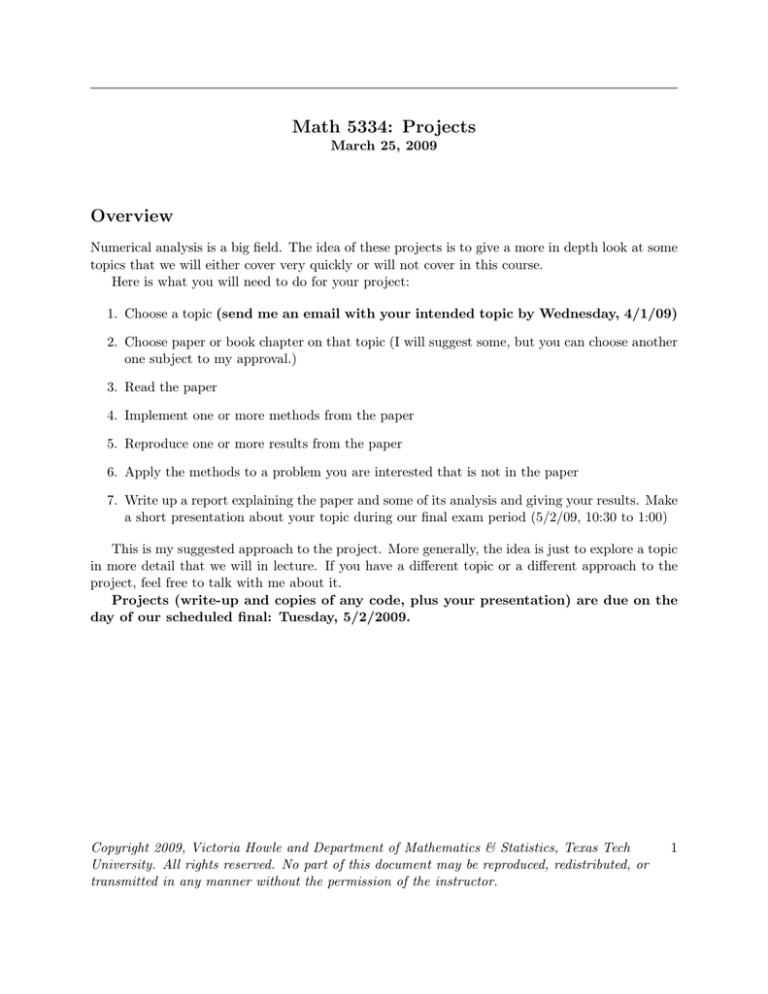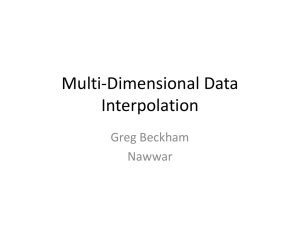
Math 5334: Projects
March 25, 2009
Overview
Numerical analysis is a big field. The idea of these projects is to give a more in depth look at some
topics that we will either cover very quickly or will not cover in this course.
Here is what you will need to do for your project:
1. Choose a topic (send me an email with your intended topic by Wednesday, 4/1/09)
2. Choose paper or book chapter on that topic (I will suggest some, but you can choose another
one subject to my approval.)
3. Read the paper
4. Implement one or more methods from the paper
5. Reproduce one or more results from the paper
6. Apply the methods to a problem you are interested that is not in the paper
7. Write up a report explaining the paper and some of its analysis and giving your results. Make
a short presentation about your topic during our final exam period (5/2/09, 10:30 to 1:00)
This is my suggested approach to the project. More generally, the idea is just to explore a topic
in more detail that we will in lecture. If you have a different topic or a different approach to the
project, feel free to talk with me about it.
Projects (write-up and copies of any code, plus your presentation) are due on the
day of our scheduled final: Tuesday, 5/2/2009.
Copyright 2009, Victoria Howle and Department of Mathematics & Statistics, Texas Tech
University. All rights reserved. No part of this document may be reproduced, redistributed, or
transmitted in any manner without the permission of the instructor.
1
Math 5334 — Projects
March 25, 2009
Topics
Multidimensional Interpolation
We discussed several 1D interpolation methods. Interpolation is an important technique in many
problems of more than one variable. In this project you will explore 2D interpolation using methods
such as bilinear, biquadradic, or bicubic interpolation or 2D splines.
You will choose some 2D data (xk , yk , zk ) and code up an use a couple of 2d interpolation
methods (splines, bi-cubic, etc.) to interpolate and find a function P (x, y) where P (xk , yk ) = zk
for the given data.
Related articles:
• J-P Berrut and L.N. Trefethen, “Barycentric Lagrange Interpolation,” SIAM Review, Vol.
46, Issue 3, 2004.
• M. Berzins, “Adaptive Polynomial Interpolation on Evenly Spaced Meshes,” SIAM Review,
Vol. 49, Issue 4, pp. 604-627, 2007.
• Crain, I.K., “Computer Interpolation and Contouring of Two-Dimensional Data: A Review,”
Geoexploration, Vol.8, pp.71-86, 1970.
• Petrie, G. & T.J.M. Kennie, “Terrain Modelling in Surveying and Civil Engineering,” ComputerAided Design, Vol.19, No.4, pp.171-187, May 1987.
Optimization
We cover only some basic 1D optimization in class. Many problems are functions of more than
one variable. There are many optimization methods including methods that use no derivative
information, methods that require first derivatives, and methods that require first and second
derivatives. In this project you will explore some standard 2D (or more) optimization.
We talked about Newton’s method for functions of a single variable.
xn+1 = xn −
f 0 (xn )
f 00 (xn )
The idea extends naturally to more dimensions by taking f 0 (xn ) to be the gradient vector and
f 00 (xn ) to be the Hessian matrix of second derivative. (Division then becomes inversion, or a linear
solve.)
Some other common optimization methods include:
• Steepest descent
• Quasi-Newton methods, e.g., BFGS
• Nelder-Mead (Simplex) method
Copyright 2009, Victoria Howle and Department of Mathematics & Statistics, Texas Tech
University. All rights reserved. No part of this document may be reproduced, redistributed, or
transmitted in any manner without the permission of the instructor.
2
Math 5334 — Projects
March 25, 2009
• Conjugate Gradients (we will discuss using CG for solving linear systems later in the course)
• Pattern Search
In this project, you will choose either a couple of fairly simple problems, or perhaps one harder
problem from your field, with some parameters to be optimized.
To do the article version of the project, choose an article (some suggestions are given below)
and follow the directions given previously on page 1.
Another option would be to choose several optimization methods, including at least one derivativebased method and one derivative-free method. Explore these methods on your optimization problems. How fast do they converge? How many function evaluations were required? How good was
the “optimal value” found? In what circumstances would you choose each of the different methods?
Some related articles:
• T.G. Kolda, R.M. Lewis, and V. Torczon, “Optimization by Direct Search: New Perspectives
on Some Classical and Modern Methods,” SIAM Review, Vol. 45, Issue 3, pp. 385-482, 2004.
• P.T. Boggs and J.W. Tolle, “Sequential Quadratic Programming,” Acta Numerica, 1995, pp.
1 - 51.
Quadrature
In class, we primarily cover Newton-Cotes formulas for quadrature. These methods are based
on interpolation with polynomials evaluated at equally-spaced points. We may choose the spacing
adaptively, but on each subregion, points are equally spaced. Another important class of quadrature
methods, which we covered only lightly, are based on allowing the intervals between interpolation
points to vary. Gaussian quadrature is an example of class of methods that use unevenly spaced
points, and is typically more accurate than a Newton-Cotes method for a given number of function
evaluations.
Another important extension of what we cover in class is the extension to multidimensional
integrals. One class of methods in this case are the Monte Carlo methods and quasi-Monte Carlo
methods.
Some related articles:
• G.H. Golub and J.H. Welsch, “Calculation of Gauss Quadrature Rules,” Mathematics of
Computation, Vol. 23, No. 106, pp. 221-230+s1-s10, 1969.
• S. Haber, “Numerical Evaluation of Multiple Integrals,” SIAM Review, Vol. 12, Issue 4, pp.
481-526, 1970.
ODEs
Extensions to the ODE methods we covered.
dimensional ODE problem.
For example, finite difference solution of a 2-
Copyright 2009, Victoria Howle and Department of Mathematics & Statistics, Texas Tech
University. All rights reserved. No part of this document may be reproduced, redistributed, or
transmitted in any manner without the permission of the instructor.
3
Math 5334 — Projects
March 25, 2009
Eigenvalues
Extensions to eigenvalue methods that we will cover.
PageRank
Chapter 1 includes a brief section on some aspects of PageRank, which is the algorithm used by
Google for web searching. In this project you will explore PageRank, the math and algorithms
behind it, and do some experiments in Matlab with web searching.
You will get more insight into PageRank when we cover eigenvalues later in the course. But you
can get started with this project by exploring the link structure of the web as described in section
2.11.
What do eigenvalues have to do with web searching? What eigenvalue algorithm does Google
use?
Iterative methods
Explore some of the iterative methods we do not cover. I intend to cover conjugate gradients and
perhaps GMRES. There are many iterative methods and some work better on some problems than
others. Investigate other itereative methods.
In practice, iterative methods do not perform well on problems without a step known as “preconditioning.” Investigate preconditioning strategies for iterative methods. Some examples include
an incomplete LU factorization and multigrid.
Copyright 2009, Victoria Howle and Department of Mathematics & Statistics, Texas Tech
University. All rights reserved. No part of this document may be reproduced, redistributed, or
transmitted in any manner without the permission of the instructor.
4







